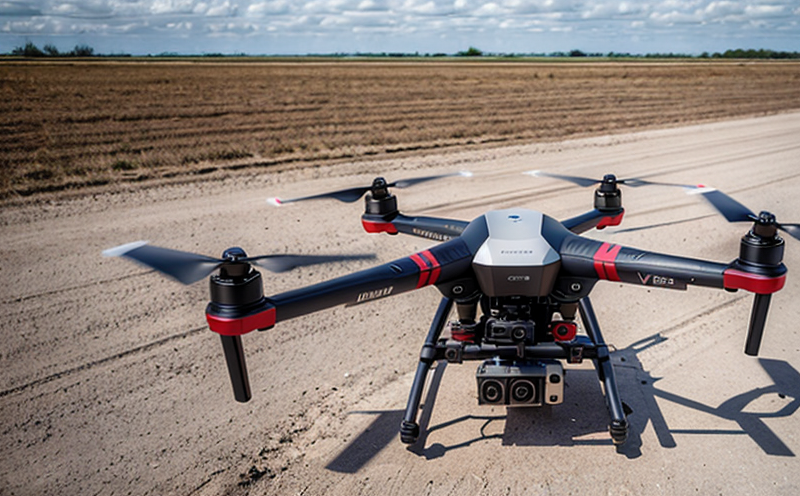RTCA DO-254 UAV Avionics Hardware Verification Testing
The RTCA/DO-254 standard is a crucial guideline in the aerospace and aviation sector, ensuring that avionics hardware meets the necessary requirements for safety, reliability, and functionality. This standard applies to Unmanned Aerial Vehicle (UAV) systems as well, emphasizing the importance of rigorous testing throughout the development lifecycle.
The primary goal of RTCA DO-254 UAV Avionics Hardware Verification Testing is to ensure that all hardware components used in UAVs are thoroughly validated and verified. This process involves a series of methodologies aimed at identifying potential issues early on, thereby minimizing risks during flight operations. The testing covers various aspects including software integration, electromagnetic compatibility (EMC), environmental stress screening, and more.
For quality managers and compliance officers within the aerospace industry, adhering to these standards ensures that UAV systems meet regulatory requirements. This is especially critical for companies involved in research and development (R&D) where innovative avionics technology is being explored. By implementing RTCA DO-254 testing protocols, organizations can enhance their product’s safety while also ensuring compliance with international aviation regulations.
From a procurement perspective, understanding the intricacies of this standard helps in selecting suppliers who adhere to high standards of quality and reliability. The testing process not only ensures that the hardware functions correctly but also provides assurance about its long-term performance under various conditions. This is particularly important for UAV systems which must operate reliably across diverse environments ranging from urban landscapes to remote terrains.
Given the complex nature of UAV avionics, comprehensive verification and validation testing are essential. These tests help in identifying any potential weaknesses or design flaws that could compromise system performance during critical operations such as data transmission, navigation, and sensor calibration. Through meticulous testing procedures outlined by RTCA DO-254, manufacturers can gain confidence that their products will perform consistently across all intended uses.
The significance of this standard extends beyond mere compliance; it represents a commitment to excellence in aerospace engineering practices. By embracing rigorous testing methodologies prescribed by RTCA DO-254, organizations demonstrate their dedication towards producing safe and reliable UAV avionics solutions. This approach fosters trust among end-users who rely on these advanced technologies for critical missions ranging from search-and-rescue operations to aerial photography.
Scope and Methodology
The scope of RTCA DO-254 UAV Avionics Hardware Verification Testing encompasses several key areas aimed at ensuring the safety, reliability, and performance of avionic systems in unmanned aerial vehicles. The testing process involves a series of meticulously designed procedures intended to identify any potential issues early on, thereby minimizing risks during flight operations.
The methodology begins with thorough documentation which includes detailed descriptions of each hardware component’s function within the overall system architecture. This documentation serves as a foundation for subsequent stages of testing where specific test cases are developed based on these specifications. Once implemented, these tests are executed using state-of-the-art instrumentation capable of simulating real-world conditions experienced by UAVs during operation.
A major component of this process involves electromagnetic compatibility (EMC) testing which ensures that all electronic components function correctly despite being exposed to various electromagnetic environments typical in aviation applications. Another critical aspect is environmental stress screening where hardware undergoes rigorous tests designed to replicate harsh weather conditions and other challenging operational scenarios encountered by UAVs.
Furthermore, software integration tests play a vital role in verifying that software interactions with hardware are seamless and error-free throughout the entire lifecycle of the product. This includes validating interfaces between different modules within the avionics suite as well as ensuring compatibility across various operating platforms.
The testing process also encompasses rigorous validation efforts focused on identifying potential design flaws or manufacturing defects early in development cycles. By employing advanced analytical tools, engineers can detect subtle anomalies that might otherwise go unnoticed during initial stages of production. Such proactive measures significantly enhance the overall quality and reliability of UAV avionics solutions.
Eurolab Advantages
At Eurolab, our commitment to excellence in aerospace and aviation testing is reflected in our comprehensive suite of services tailored specifically for unmanned aerial vehicle (UAV) systems. Leveraging cutting-edge technology and experienced personnel, we offer unparalleled expertise when it comes to RTCA DO-254 UAV avionics hardware verification testing.
Our state-of-the-art facilities provide an ideal environment for conducting precise tests that adhere strictly to international standards such as ISO, ASTM, EN, and IEC. With a focus on precision and accuracy, our team ensures that each test meets the highest quality benchmarks required by regulatory bodies worldwide.
The advantages of choosing Eurolab for your UAV avionics hardware verification testing are numerous. Our experienced engineers possess extensive knowledge in both theoretical concepts and practical applications related to aerospace engineering practices. This deep understanding allows us to provide customized solutions that address specific needs unique to your project requirements.
We offer unparalleled support throughout the entire testing process, from initial consultation through final reporting. Our team works closely with clients to ensure full transparency regarding test procedures and results. By maintaining open lines of communication, we foster a collaborative atmosphere where feedback is valued and incorporated into ongoing improvements.





